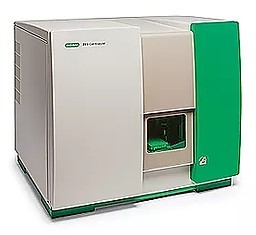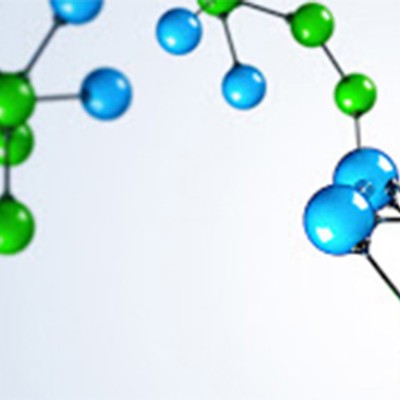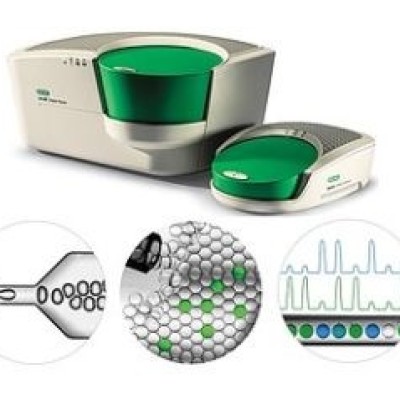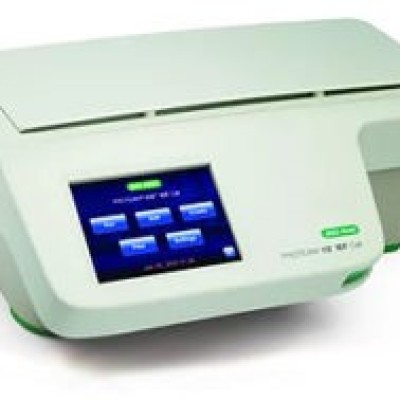
ZE 5- Cell Analyzer

The ZE5- Cell analyzer is a new innovative flow cytometry system. With 2 to 28 parameter options, it is a system that can be used by all researchers from beginners to experienced users and can be updated according to their needs.
- Fully automated 384-well plate – 5 mL tube option
- 5 laser options in the range of 355nm-640nm
- 28 fluorescent detectors
- Temperature-controlled loading
- Plate shaker feature
- Since there is no dead volume, the sample is not wasted, it is returned to the unused sample tube.
S3E- Sorter

The S3 Sorter is an automated bench-top system with options for up to 4 lasers and forward / side-scatter detectors. It performs exceptionally pure cell separation without sacrificing performance and precision. It is ideal for the differentiation of antibodies and fluorescently labeled cells.
Operate the system quickly and easily – automatic drop-delay and droplet break-off monitoring allows 1-4 color sorting.
2-way sorting – Sort two different cell populations simultaneously.
High speed and purity – sort cells fast, without sacrificing precision and purity.
TC20- Cell Counter

- The TC 20 automatic cell counter counts mammalian cells in less than 30 seconds in a single step, with its autofocus feature and updated cell counting algorithm.
- Counts cells and particles in the range of 5-60 µm.
- It solves the standardization problems that may arise with auto-focus and manual focusing.
- Cell size is limited by gating, preventing debris measurement
- Ability to store up to 100 counts on itself and save with USB
- With the use of trypan blue dye, it can distinguish between dead and alive.
ZOE- Imaging System

Meet ZOE – say goodbye to the darkroom!
- LED simple light and multi-channel fluorescent imaging for routine cell culture and imaging
- 20x objective, 10.1 inch touchscreen, 2500 jpeg image memory, USB output
- Ability to superimpose pictures without the need for a computer
- Imaging with various cell culture plastics such as slide, petri dish, flask

In-Fusion Cloning

The In-Fusion Cloning HD Plus system is a technology that allows cloning from any region of any vector that does not require ligation or restriction enzyme in 15 minutes, does not require verification thanks to its directional insert, and thus gives a new perspective to cloning.
- It works with 95% efficiency – fragments from 0.5kb to 15kb can be cloned.
- It can be used for site-directed mutagenesis, Insertion/deletion, multiple fragment cloning studies.
- Accurate cloning – No extra base is added as in TA cloning or enzymatic cloning.
Transfection

Transfection is one of the methods frequently used in cell culture studies. Therefore, it is important that the agent used does not have a toxic effect on cells, ensures transfection in a short time, and works efficiently in a wide cell spectrum. With the polymer-based Xfect agents it has developed, Takara minimizes cell toxicity and reduces transfection time up to 4 hours. It also does not require the use of Opti-MEM medium.
Viral Transduction




Transduction; It is the process of transferring a gene or genes to cells by means of a viral vector or virus. In gene therapy studies, it is very important to perform gene transfer easily and efficiently.
Takara's broad portfolio of mammalian systems provides vector systems suitable for your work and offers new solutions to streamline your workflow.
CRISPR Cas-9

The CRISPR/Cas system is a prokaryotic immune system that normally breaks DNA locally using non-coding RNAs and Cas9 proteins. These breaks in DNA activate one of two different DNA repair mechanisms depending on the conditions in the cell: "Non-homologous end joining DNA repair pathway (NHEJ) or "Homology-directed repair (HDR) pathway". This system found in prokaryotes has been adapted to mammalian systems, thus reducing it to a simple RNA programmable method for use in genome modification studies. As a result of breaks in DNA created by the genome CRISPR/Cas system, the NHEJ repair mechanism activated by the cell performs knock-out in the target region, or the HDR mechanism performs knock-in in the target region. This technology has made genome editing work significantly easier and more efficient, taking this type of work to a much higher level.
sgRNA Transcription and Screening Kits
Nano Tarnsport CRISPR/Cas9 System
IDT Technologies
Get fast and high quality solutions with high quality oligos produced with proprietary synthesis platforms of IDT, the world's largest oligo producer and pioneer in its field.

CRISPR GENOME EDIT
The use of CRISPR (Regularly Intermittent Split Palindromic Repeat Sets) and the enzyme Cas9 in genome editing has been a major technological breakthrough that has made genome modification in cells or organisms faster, more efficient and more robust than previous methods.
Alt-R CRISPR Systems were developed as a result of extensive research at each stage in the CRISPR-mediated process of creating a double-stranded DNA break, a critical step for gene editing and DNA insertion by homologous recombination.
Alt-R CRISPR-Cas9 System
The Alt-R CRISPR-Cas9 System is an optimized genome editing solution that outperforms other CRISPR approaches for targeted double-stranded DNA breaks.
It contains all the necessary reagents for genome editing based on the S. pyogenes CRISPR-Cas9 system. Thanks to Alt-R HiFi CRISPR-Cas9 nuclease, more efficient results are obtained by reducing off-target activity. With the Alt-R CRISPR-Cas9 System, you can take advantage of the latest developments in on-target and off-target designs, design your guide RNAs, or choose from ready-made designs.
Alt-R CRISPR-Cas12a (Cpf1) System
The Alt-R CRISPR-Cas12a System allows targeting of alternative regions not available in the CRISPR-Cas9 System. In the CRISPR-Cas12a genome editing method, Cas12a endonuclease is used to create a double strand break containing 5′ DNA extensions. It can be used to target AT-rich regions.
CRIPSPR Nucleases
Recombinant, high-purity Cas9 and Cas12a (Cpf1) endonucleases for genome editing studies. High purity enzyme is obtained thanks to the codons optimized for .coli expression. High efficiency is achieved thanks to nuclear localization signals (NLSs).
Cas13 guide RNA (Cas13 gRNA)
Using the Cas13 enzyme and virus-targeted guide RNAs, which are central to the SHERLOCK assays, viral RNAs can be digested. The SHERLOCK mechanism can detect viral contamination in samples using FAM-labeled reporter RNAs other than Cas13 and guide RNAs. With this method, it is possible to detect the presence of viruses such as Zika or dengue virus in the patient. Currently, the use of this method is rapidly becoming widespread in the detection of SARS-CoV-2 virus. You can contact us for your Cas13 gRNA orders with the features you want.
RNA Interference Kits
Dicer-Substrate Short Interfering RNA (DsiRNAs) and TriFECTa® Kit
Dicer enzyme is a component of RISC (RNA induced silencing complex) and mediates entry of siRNA (short interfering RNA) into RISC. Conventional 21mer siRNAs mimic the products resulting from the Dicer process and therefore do not interact with the Dicer enzyme in RNA interference studies. 27mer DsiRNAs show greater efficacy in RNA interference than conventional 21mer siRNAs.
You can choose from 320,000 DsiRNA designs or create your own. You can order all the reagents required to work with the TriFECTa RNAi Kit at once. You can contact us to get support on design and to get more information.
23 / 5000
Cycles Results
Stem Cell Research

Stem Cells are unspecialized cells with unlimited self-renewal capacity. These unspecialized cells have the ability to transform themselves into specific cell types when necessary, thus they have very important roles in homeostasis and tissue regeneration (1,2).
In addition, after the stem cells turn into a special cell, these transformed (somatic) cells can regain their embryonic stem cell characteristics with intracellular programming as a result of changing conditions. Cells that regain their stem cell properties in this way are called iPSC (induced Pluripotent Stem Cell) (2,3) iPSCs have an important place in stem cell studies because they do not cause ethical problems and are very similar to stem cells (3).
- Nadig, 2009. Stem cell therapy – Hype or hope? A review. J Conserv Dent. 12(4): 131–138.
- Lin, S. L. (2011). Concise review: Deciphering the mechanism behind induced pluripotent stem cell generation. Stem cells, 29(11), 1645-1649.
- Jung, Y., Bauer, G., & Nolta, J. A. (2012). Concise review: induced pluripotent stem cell‐derived mesenchymal stem cells: progress toward safe clinical products. Stem cells, 30(1), 42-47.
İnductived Pluripotent Stem Cell (IPS)
Stem Cell Modification Medium and Kits
Stem Cell Medium and Additives
Stem Cell Medium Selection Guide
T-CELL THERAPY

It is a method that allows patients to recognize and attack cancer cells as a result of changing their own T-cells in a laboratory environment.
Takara provides an “end to end” solution in research with its product portfolio that includes specific antibodies from medium to transduction solutions, culture bags for T-cell proliferation.





